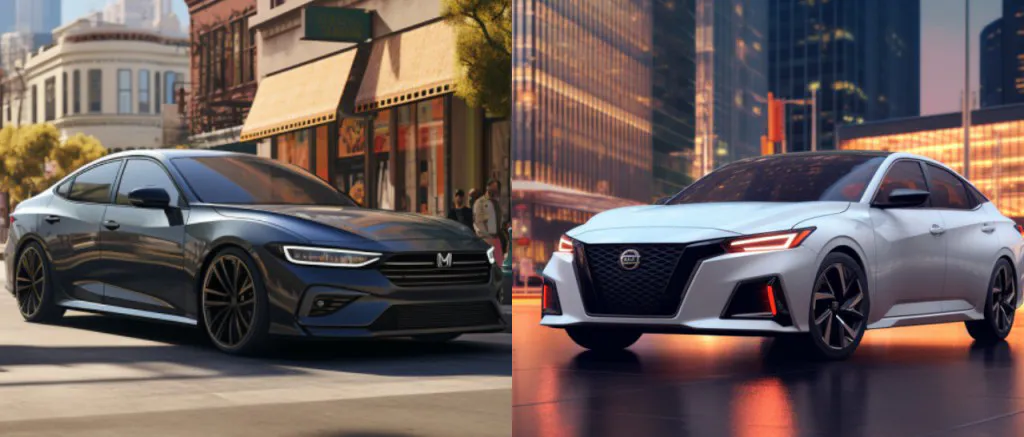You don’t have to be a car nerd such as myself to realize the traditional mid-size sedan is gasping for survival under the relentless onslaught of crossovers and SUVs here in the USA. You know it’s bad when major automakers like Ford straight up abandon making cars altogether.
However, all is not lost for those who still prefer a regular car as Nissan and Honda remain hard at work building solid options.
Over at Nissan, the Altima has been in continuous production since 1992. The 6th-generation model arrived in 2018 and since then, the Altima has stood out from the crowd with options like all-wheel drive (AWD) and a sporty SR VC-Turbo variant.
Honda’s Accord has a history going back to 1976 and as of 2023 is strutting about in sleek new 11th-generation duds. This new lineup is hybrid-heavy, a powertrain not offered in the Altima, but gone are the days of sport-minded Accords with manual transmissions.
With so much in common, how’s a shopper supposed to decide which of these mid-size sedans is better? The comparison below is a good place to start as it parses the nitty gritty details to shine a light on the strengths and weaknesses of the latest Altima and Accord.
To that end, we’ll be comparing powertrain specifications, technology offerings, and creature comforts in both cars. We’ll also factor in published safety scores per the National Highway Traffic Safety Administration (NHTSA), 5-year ownership costs from Edmunds, and fuel economy figures from FuelEconomy.gov.
If you’re also interested in finding out how these two mid-size sedans compare on the used market, our Altima vs. Accord comparison compares notes going back 20 years with an in-depth analysis of reliability,, repair costs, and owner feedback.
And if you’re looking to cross-shop these cars against the competition, our best and worst model year series of articles for the Ford Fusion, Pontiac G6, Toyota Camry, and Chevy Malibu are worth checking out.
Find details about the methodology used for this comparison at the bottom of the page.
2023 Honda Accord vs Nissan Altima | A Guide to Trim Levels & Optional Features
Trim Levels: Starting Prices
Quick Take: Both cars have similar entry-level and range-topping prices, but offer vastly different vehicles.
The respective base models of these two cars, a 2023 Altima S and a 2023 Accord LX, have a price tag within $600 of one another. That money nets a vehicle with similar content and performance regardless of which automaker you go with.
Key differences are that the top four Accord trim lines use a hybrid powertrain, something not offered by the Altima. However, the priciest Altima in SR VC-Turbo trim has serious sporting capability with its 248-horse turbocharged motor, which the Accord can’t compete with.
| 2023 Honda Accord Model | Starting Price |
| LX | $27,295 |
| EX | $29,060 |
| Sport Hybrid | $31,345 |
| EX-L Hybrid | $32,990 |
| Sport-L Hybrid | $33,325 |
| Touring Hybrid | $37,340 |
| 2023 Nissan Altima Model | Starting Price |
| S | $26,725 |
| SV | $27,525 |
| SR | $28,925 |
| SR VC-Turbo | $36,425 |
| SL | $33,425 |
Cost of Ownership
Quick Take:
The table below is a distilled version of what Edmunds publishes when it comes to long-term ownership costs of a new Altima and Accord. As we know from above, these cars have similar starting prices, but over 5 years, the Nissan will cost you around $2,7000 more to keep on the road.
That stems from a higher cost per mile figure and $1,700 in additional maintenance bills. Fuel costs are identical and repair bills are in the Altima’s favor, but depreciation takes a smaller bite out of the Accord. This latter figure comes into play when you decide it’s time to sell your car, so is worth bearing in mind.
| 5-Year Ownership Cost | ||
| Costs | 2023 Honda Accord | 2023 Nissan Altima |
| Cost to Own | $37,004.00 | $39,703.00 |
| Average Cost Per Mile | $0.49 | $0.53 |
| Depreciation | $12,511 | $13,902 |
| Fuel | $8,466 | $8,466 |
| Maintenance | $3,559 | $5,257 |
| Repairs | $789 | $665 |
2023 | Honda Accord vs Nissan Altima | Specifications | Safety, Interior and Exterior Features
Vehicle Class & Body Style:
Quick Take: These cars occupy the same EPA classification, but the Accord is bigger in most metrics.
The US EPA classifies cars based on passenger volume, which puts the Altima and Accord in the same segment. However, the Honda’s overall passenger volume is a significant 5 cubic feet greater than the Nissan’s. As well, the Accord measures 3 inches longer overall and delivers almost 6 more inches of rear legroom.
We’ll look at the rest of the dimensions in more detail below, but the takeaway here is how important it is to test-drive the 2023 Altima and Accord. Just because they’re both mid-size sedans on paper doesn’t mean they measure up so closely in person.
|
2023 Honda Accord |
2023 Nissan Altima |
|
|
Class |
Mid-Size Sedan |
Mid-Size Sedan |
|
4-Door Sedan |
LX, EX, Sport Hybrid, EX-L Hybrid, Sport-L Hybrid, Touring Hybrid |
S, SV, SR, SR VC-Turbo, SL |
Powertrain:
Engine Options & Specifications:
Quick Take: Honda owns the fuel economy conversation, but the Altima stands tall when it comes to performance.
Whether you buy a new Nissan Altima or Honda Accord, performance is similar with roughly 190 horsepower on tap and a 0-60 mph time in the mid 7’s. The Altima uses a naturally aspirated 2.5L inline-4 to do so versus the turbocharged 1.5L four-pot in the Accord, but from a user perspective, performance will be similar.
As for fuel economy, it’s a close match with these motors. They share a combined rating of 32 mpg, the Accord noses ahead in city driving, but the Altima takes the highway rating. This flips to the Accord’s favor against an AWD Altima, something Honda does not offer.
Nissan’s mid-sizer also differentiates itself with the more potent SR VC-Turbo and its punchy power plant. But with up to 48 mpg combined, nothing comes close to the Accord hybrid’s efficiency. It also translates to a bladder-busting driving range of close to 600 miles.
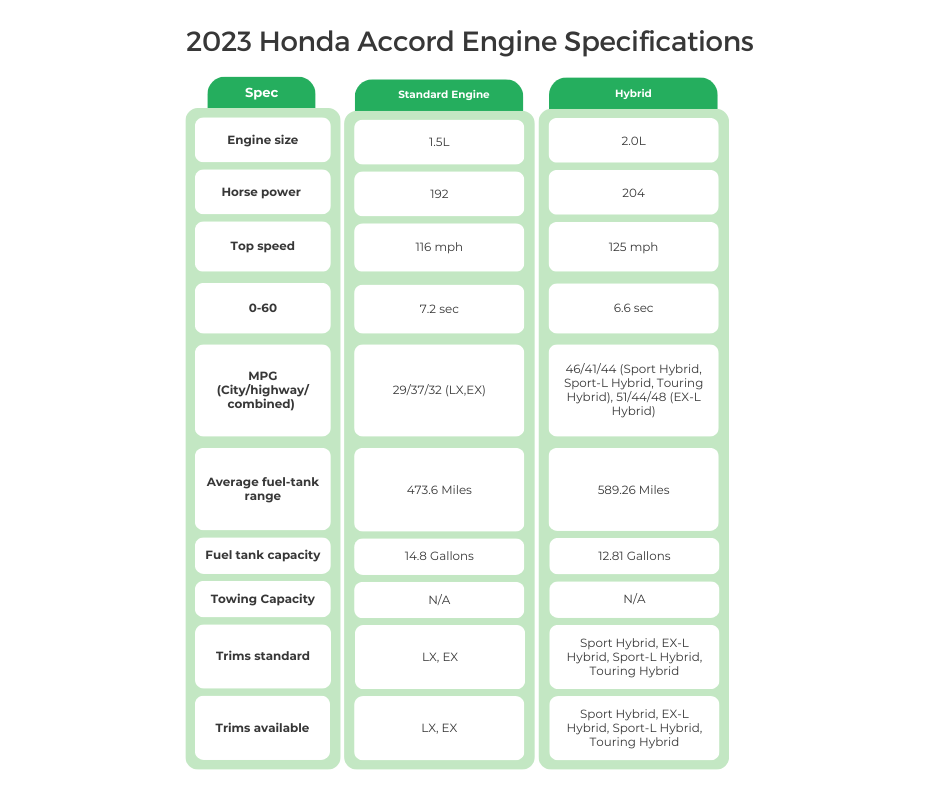
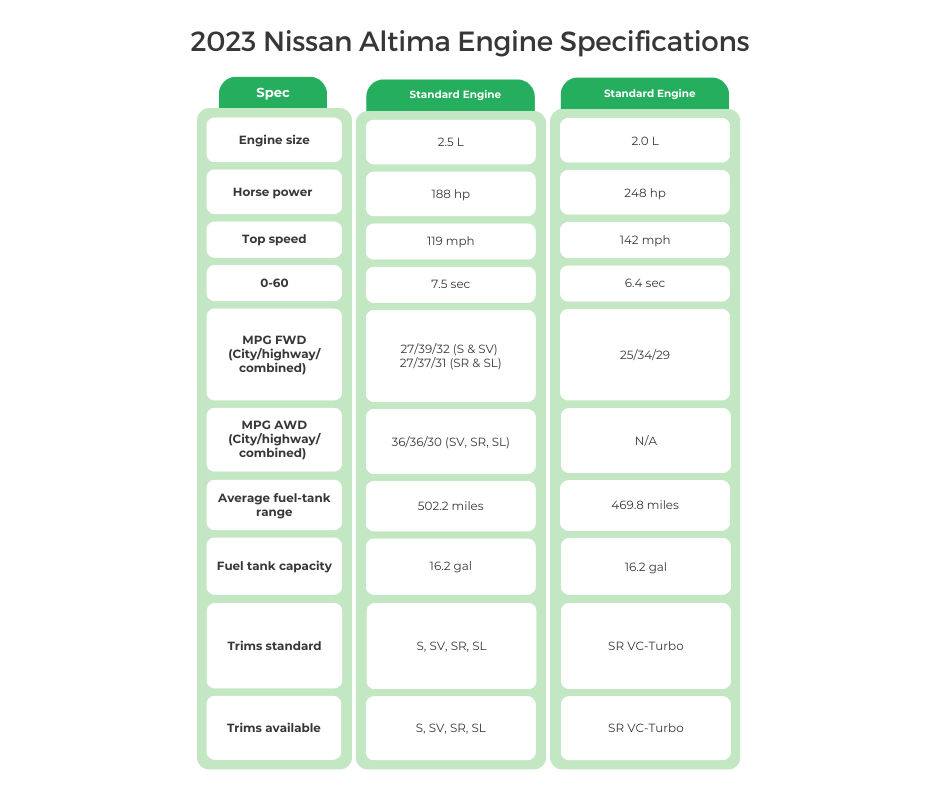
Transmission Options & Specifications:
Quick Take: You can have any transmission with the 2023 Altima and Accord as long as it’s of the continuously variable variety.
Honda offered a manual transmission in the Accord as recently as 2020, but it’s now gone as is a traditional automatic transmission in favor of a continuously variable transmission (CVT) on standard models. Hybrid Accords receive an electronic CVT, which drops the belt and pulleys entirely.
Nissan has long been a proponent of CVTs and fits one to every 2023 Altima. All of this is likely of little interest to the majority of car buyers, but if you would like more details, be sure to check out our CVT Tech Talk section below!
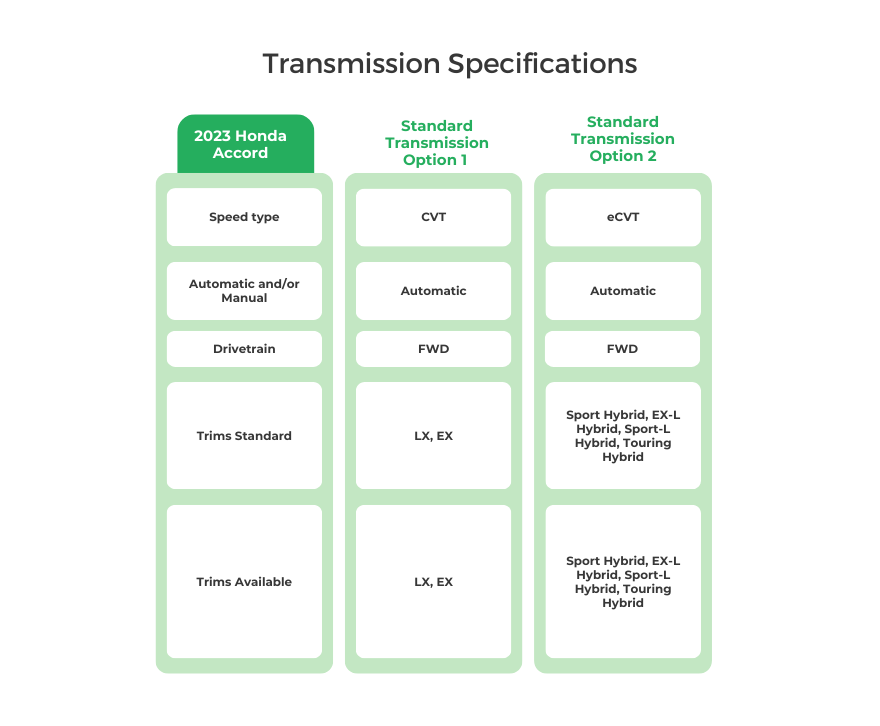
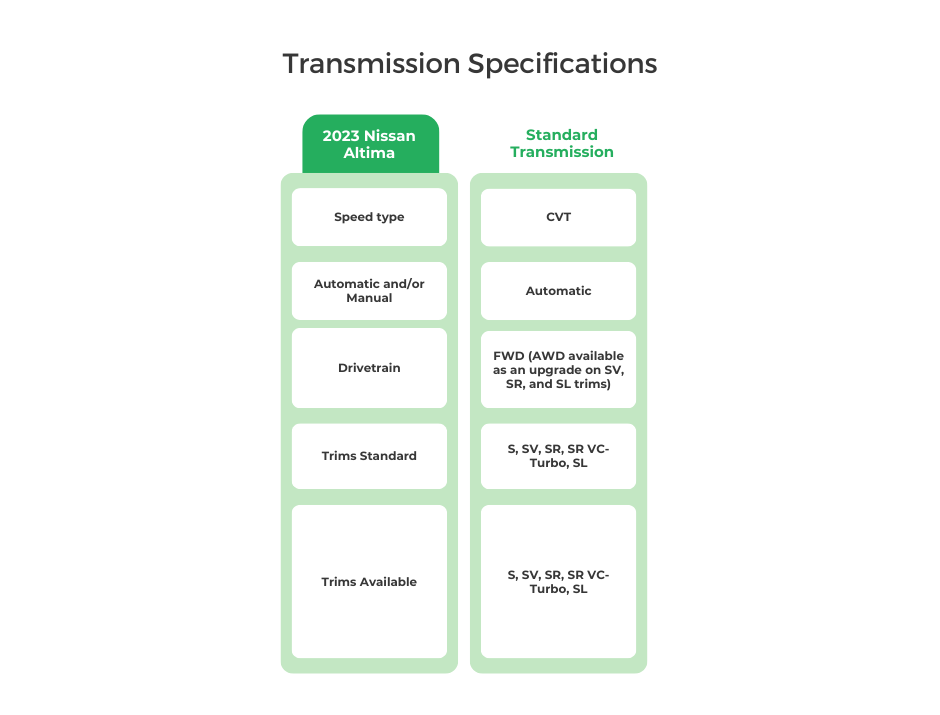
TECH TALK: CVTs
A continuously variable transmission (CVT) does not use gears like a typical automatic transmission. Instead, it has two pulleys connected by a belt. One pulley connects to the engine, and the other connects to the wheels. The belt transfers the power between the pulleys. This setup allows the pulleys to continuously change positions as needed. The CVT automatically adjusts the pulleys as required, providing smooth and efficient power delivery.
An electronic continuously variable transmission (eCVT) uses electronic controls and electric motors to vary gear ratios instead of a belt and pulley system. Unlike a regular CVT, an eCVT has no physical pulleys or belts—the gear ratio is adjusted seamlessly by controlling the speeds of electric motors and generators. This electronic control allows faster, smoother gear ratio changes compared to a traditional CVT. An eCVT also provides more flexibility, needing less space and having fewer moving parts.
Wheel Drive:
Quick Take: If AWD is a requirement, the Nissan Altima is your only option.
AWD has been slowly trickling into the mid-size sedan segment of late, but the Honda Accord continues to be FWD-only. Over at Nissan, AWD can be fitted to the Altima in SV, SR, or SL trim for an extra $1,500.
This is nice to have in especially wet driving conditions, but for those eye-balling AWD for snowy conditions, know that a decent set of winter tires are a good substitute and should cost quite a bit less.
| 2023 Honda Accord Wheel Drive | FWD | AWD | RWD |
| LX | S | ||
| EX | S | ||
| Sport Hybrid | S | ||
| EX-L Hybrid | S | ||
| Sport-L Hybrid | S | ||
| Touring Hybrid | S |
| 2023 Nissan Altima Wheel Drive | FWD | AWD | RWD |
| S | S | ||
| SV | S | U | |
| SR | S | U | |
| SR VC-Turbo | S | ||
| SL | S | U |
S = Standard
U = Available in upgrade
E= electric on-demand AWD
D= AWD with rear driveline disconnect
Safety:
Quick Take: Both of these cars hit high marks for safety, but the Accord reaches higher in several areas.
NHTSA Safety Ratings:
So far, the NHTSA has not tested a 2023 Honda Accord but going back to 2022 and the end of the previous generation, we find the Accord earned 5 stars in all NHTSA testing protocols. Given the long history of Accords earning these top scores, there’s reason to believe that when the NHTSA does test the 11th-gen model, it will be equally impressive.
The graphic for the 2023 Altima shows it brought home a 5-star overall crash-test rating. But within that, we find that the frontal and rear passenger side barrier crash tests both came in at 4 stars.
So, the latest Altima is certainly very safe and the same is likely going to be true of the new Accord, but we’ll need to wait for official results before making a final judgment.
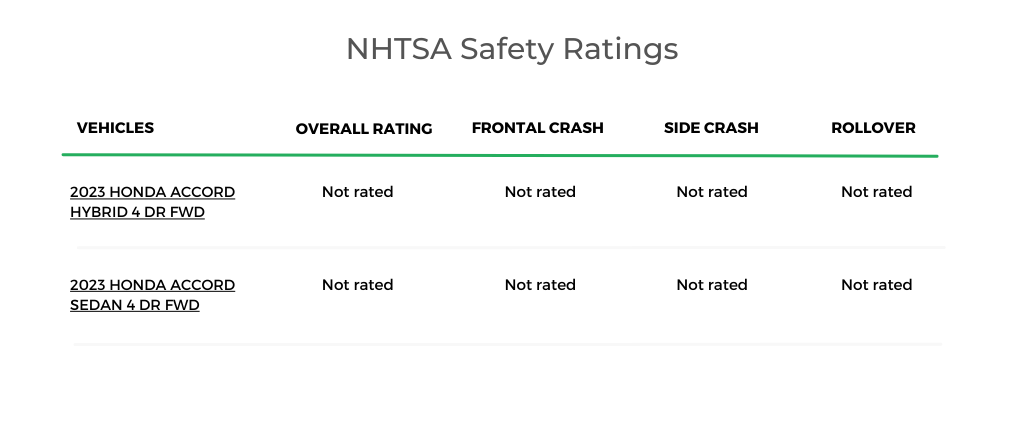
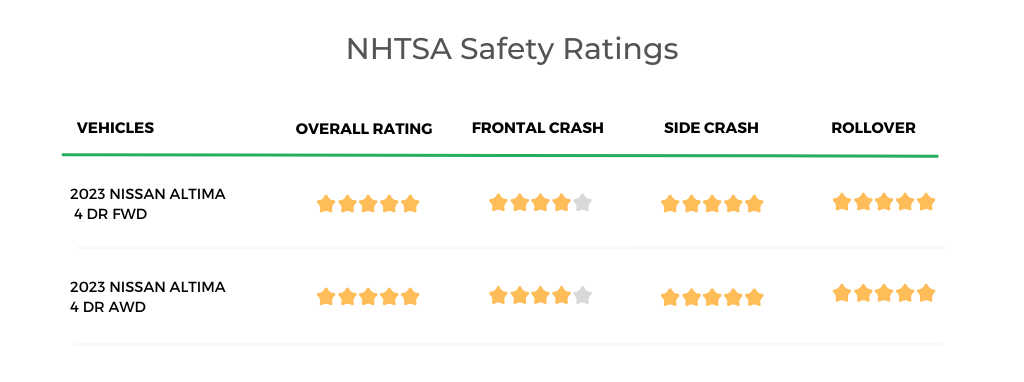
IIHS Awards:
In the case of the IIHS safety agency, both 2023 models of the Nissan Altima and Honda Accord have been tested. Like the NHTSA, the IIHS performs crash testing, but adds in protocols for roof strength, head restraints, seats, headlights, and automatic emergency braking.
As you can see in the table below, the IIHS awarded both sedans its highest rating of Top Safety Pick+. However, digging into the results reveals a few important notes in the Accord’s favor.
Across the board of these IIHS test protocols, the Accord earned a rating of Good in every instance, which is the highest possible score. The Altima, however, was rated Acceptable for the headlights, Moderate for the front overlap updated test, and Poor for the side updated test.
Poor is the lowest IIHS rating, so though the overall test results mean the Altima qualifies for a Top Safety Pick+ award, the Accord performs better.
| IIHS Award | Tested Vehicle | ||
| 2023 Honda Accord | MidSIZE CAR / 4-DOOR SEDAN | 2023 TOP SAFETY PICK + | 2023 Honda Accord EX 4-door |
| 2023 Nissan Altima | Midsize Car/4-Door Sedan | 2022 TOP SAFETY PICK + | 2019 & 2023 Nissan Altima 2.5 S 4-door |
| 2022 Nissan Altima 2.5 SV 4-door | |||
Airbags & Head Restraints:
Airbags are often overlooked these days as they’ve been around for a long time and are hidden from view until called into duty. But these passive safety devices have proven to be highly effective at their job of protecting occupants in accidents, so it’s worth paying attention to what your car has on this front.
Fortunately, it’s an easy comparison in this instance as both the 2023 Nissan Altima and Honda Accord have 10 standard airbags. That includes dual front knee airbags and side airbags for both rows of seating.
Neither vehicle offers the relatively new overhead airbag technology that is designed to protect occupants’ heads during an accident. This is also true of active head restraints, which are a whiplash-reducing system typically found on higher-end vehicles.
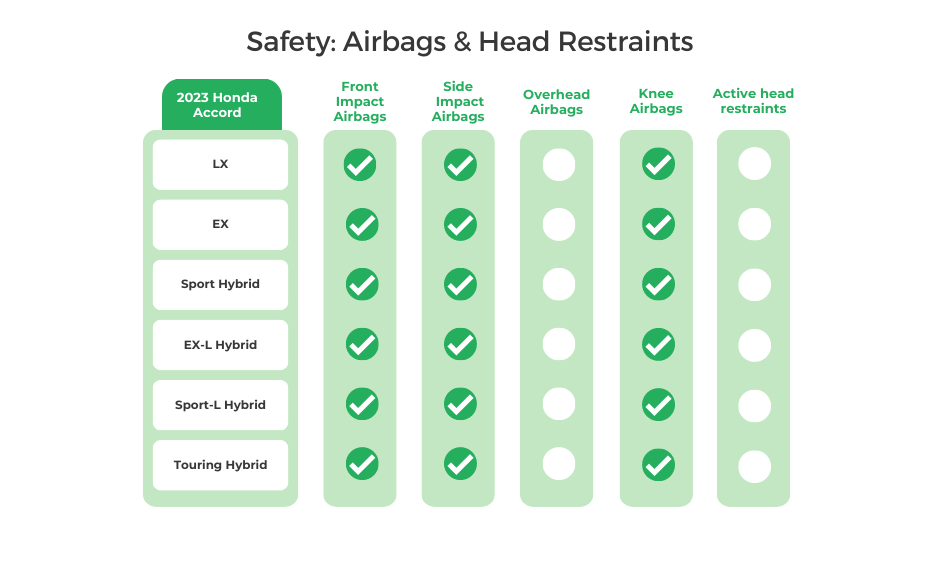
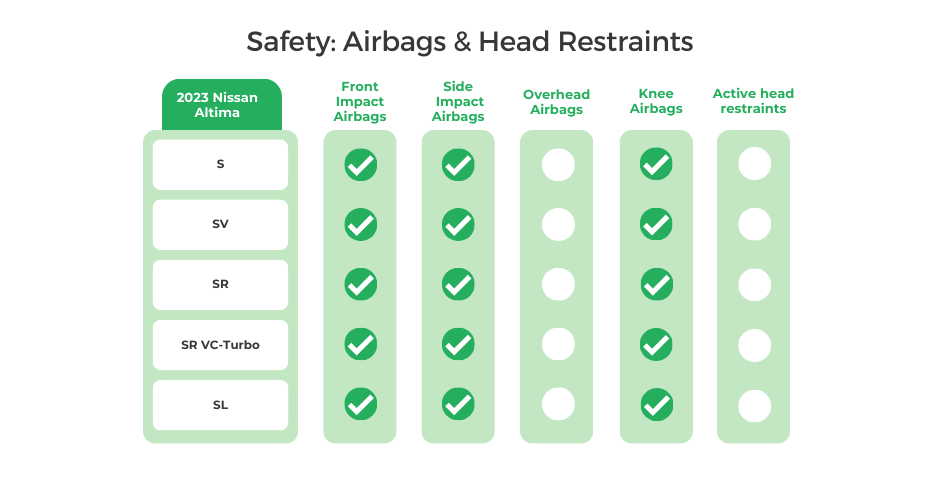
Semi-Autonomous Driving:
Unlike airbags, semi-autonomous driving technology is a hot topic in the automotive industry these days as manufacturers work towards a future where drivers can kick back and let their car be the chauffeur. We’re not there yet, but as we’ll look at in the next couple of sections, Nissan and Honda are hard at work in this space.
With the 2023 Nissan Altima, standard semi-autonomous systems include automatic emergency braking, brake assist, electronic brake force distribution, and rear automatic braking. Also included is traditional cruise control, not to be confused with the adaptive variety that manages speed and distance for you.
The 2023 Honda Accord does not include rear automatic braking as standard equipment, but it does match what the Altima makes standard along with continuous assistive steering, corrective steering, and adaptive cruise control.
Automatic parking remains a system mostly reserved for higher-end vehicles or part of an expensive package and is not available on either of these cars. Also, there is no industry standard language for the names of the various ADAS, so be sure to do your homework on how the systems you’re considering work.
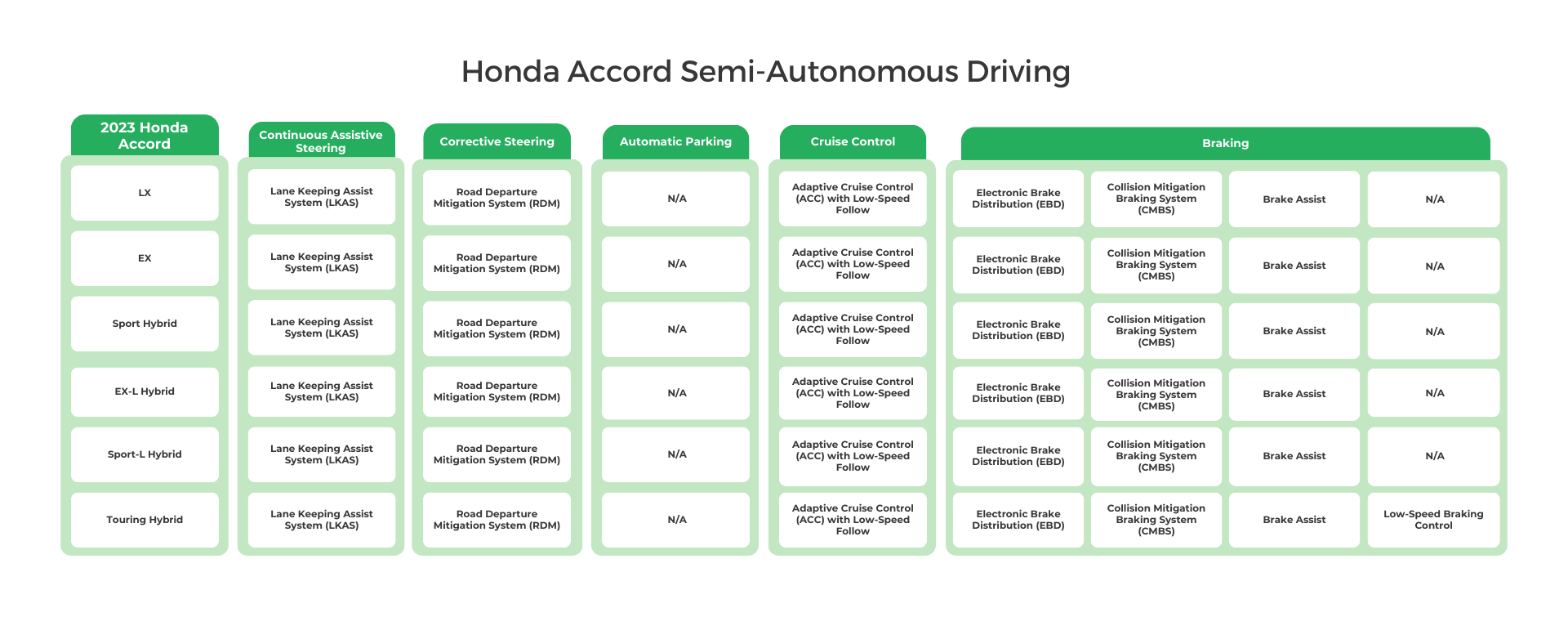
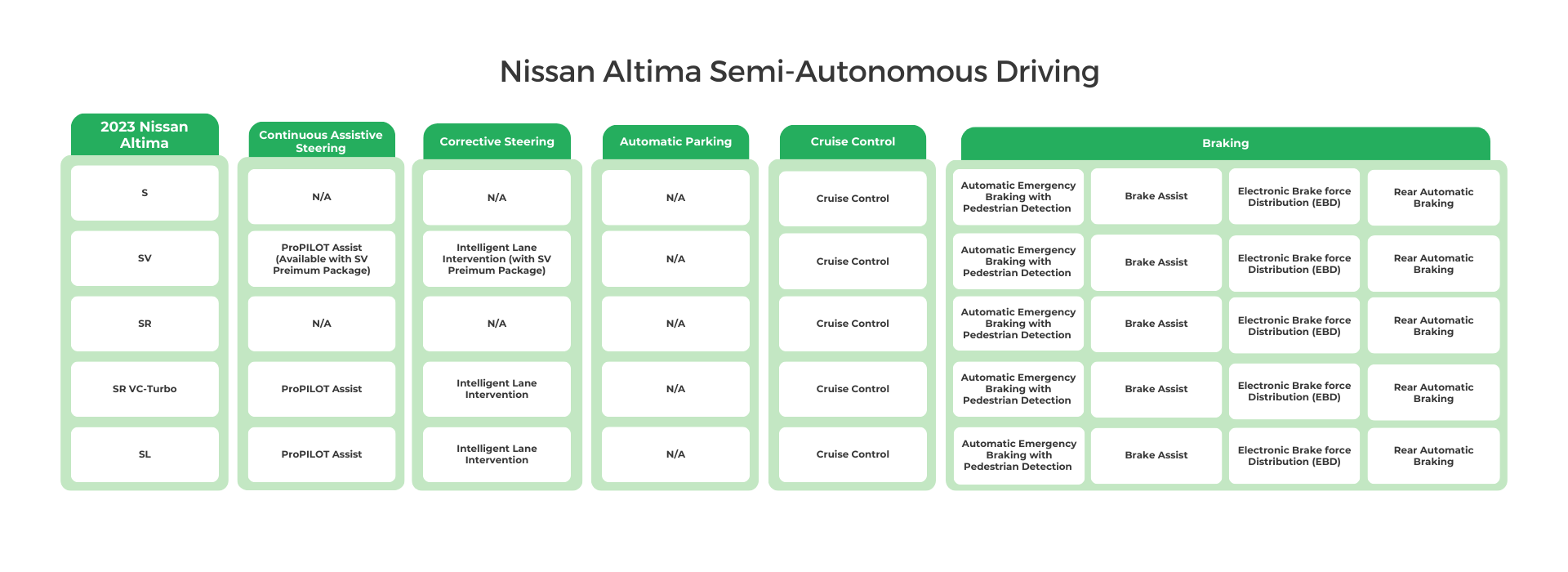
Driver Warning Systems & Telematics:
The roster of ADAS continues with driver warning and telematics systems. When you’re researching these vehicles, we should point out that Honda Sensing is what Honda calls its bundle of advanced safety tech, and Safety Shield 360 is Nissan’s name for its suite of ADAS.
As with the semi-autonomous section above, the 2023 Honda Accord has a longer list of driver warning-related systems than the 2023 Nissan Altima.
With the Altima, lane departure warning, forward collision warning with pedestrian detection, a driver-attention monitor, and blind-spot monitoring (BSM) with rear cross-traffic (RCTA) alert are all standard, while traffic sign recognition (TSR) and a telematics system are optional.
In the 2023 Accord, BSM with RCTA is optional, but the rest of what the Altima includes is standard as is TSR, telematics, and a rear occupant alert. Neither of these mid-sized sedans offers intersection turn assistance nor safe exit assist.


Road Visibility Features:
One more critical aspect of vehicle safety is road visibility, as in how well you can see the road while driving. Fortunately, scattered and dim halogen headlights are a thing of the past here as both the 2023 Altima and Accord come standard with crisp and bright LED headlights.
Automatic high beams (AHB) and a backup camera are also standard across the board. AHBs are a great feature to help avoid blinding oncoming traffic and eliminate the hassle of constantly turning your high beams on and off.
You won’t find adaptive headlights with their swiveling beams on either of these cars. However, the 2023 Accord does offer a head-up display and rain-sensing windshield wipers, neither of which are offered on the 2023 Altima.
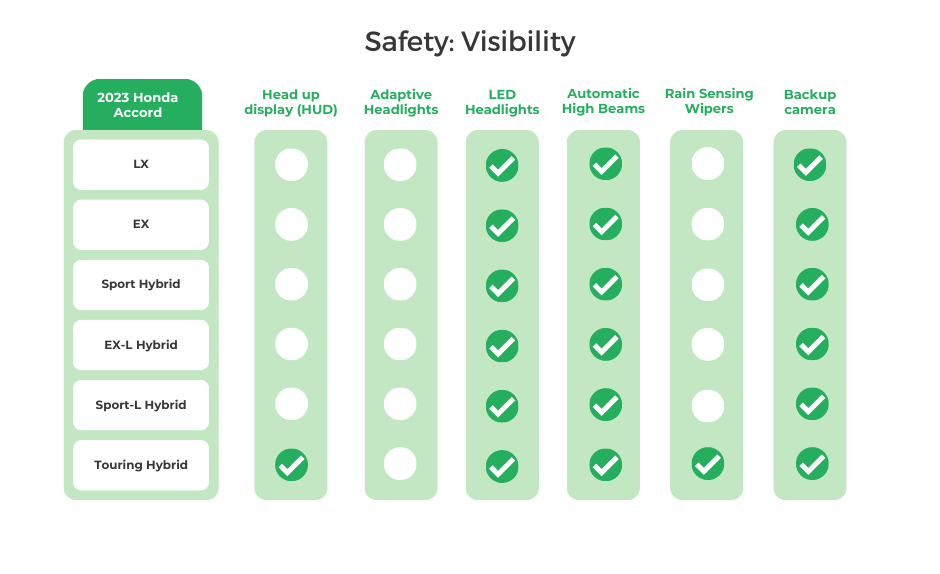
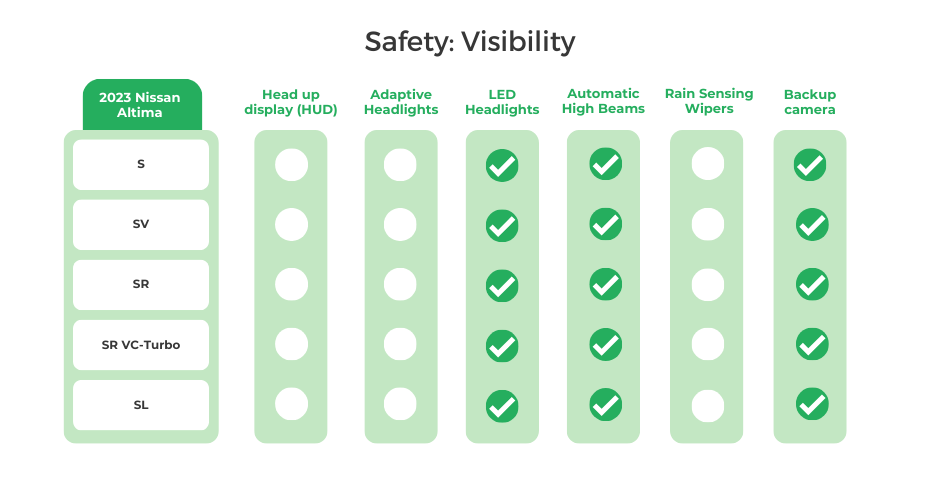
Interior:
Quick Take: Interior content is similar for these two sedans, but the 2023 Accord offers more space in nearly all dimensions.
Interior Features:
Aside from Tesla, almost every major automaker has made Apple CarPlay and Android Auto standard equipment, which is the case with the 2023 Nissan Altima and Honda Accord. It’s easy to see why with how easy it is to mirror your smartphone onto the car’s central display with this tech.
On the display front, both of these cars come standard with a 7” infotainment touchscreen and the option for a 12” unit that cuts the cord in favor of wireless smartphone integration.
Surely folks would like heated seats to be similarly ubiquitous – or at least my wife would – but this feature remains optional on these 2023 sedans.
If you’re wondering what a heated seats subscription is, you’re not alone as most consumers don’t know what this means. And that’s ok for these cars as it’s not available, but according to McKinsey, you may want to learn about it as this “Features on Demand” approach to creature comforts is set to grow aggressively in the coming years.
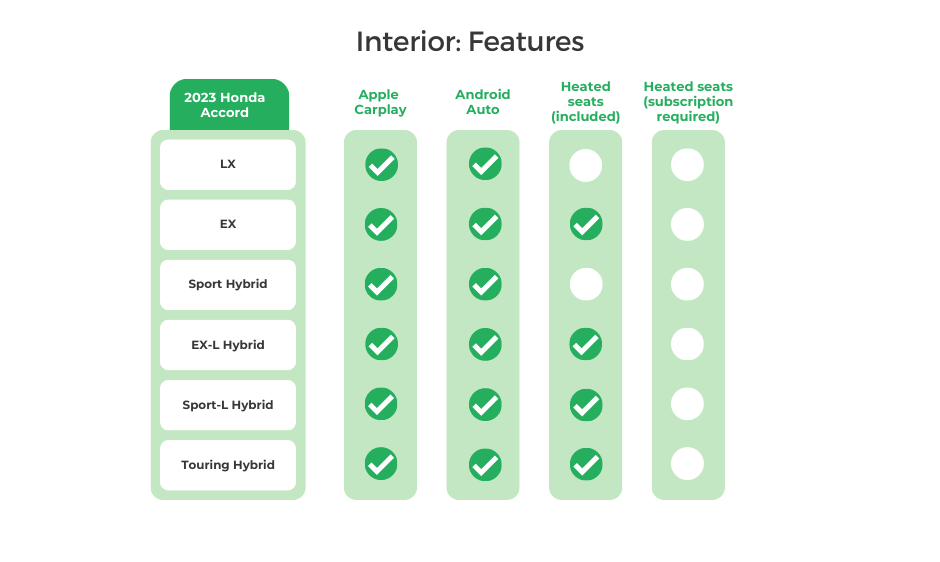
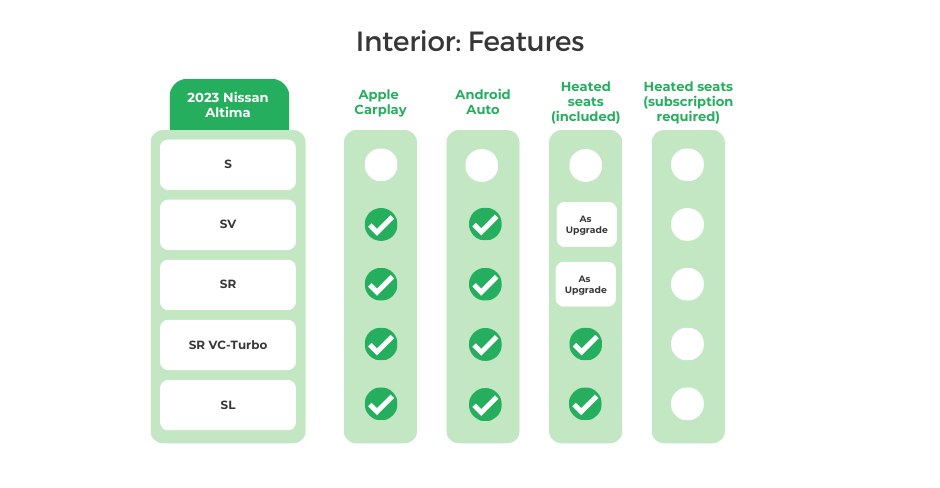
Interior Dimensions:
As noted earlier, the 2023 Nissan Altima and Honda Accord both fall in the EPA’s mid-size sedan category, but the Accord is a bigger car. The only dimensions the Altima has in its favor are an extra inch or so of front legroom and rear hiproom.
However, the Accord has nearly 6 extra inches of rear legroom, which is a relatively huge advantage. It also has an extra cube of cargo carrying capacity, and – for non-hybrid models – 5 extra cubic feet of overall passenger volume.
All that said, these on-paper metrics are helpful but are not a substitute for sitting in the cars to get a better understanding of how the space feels for your particular needs.
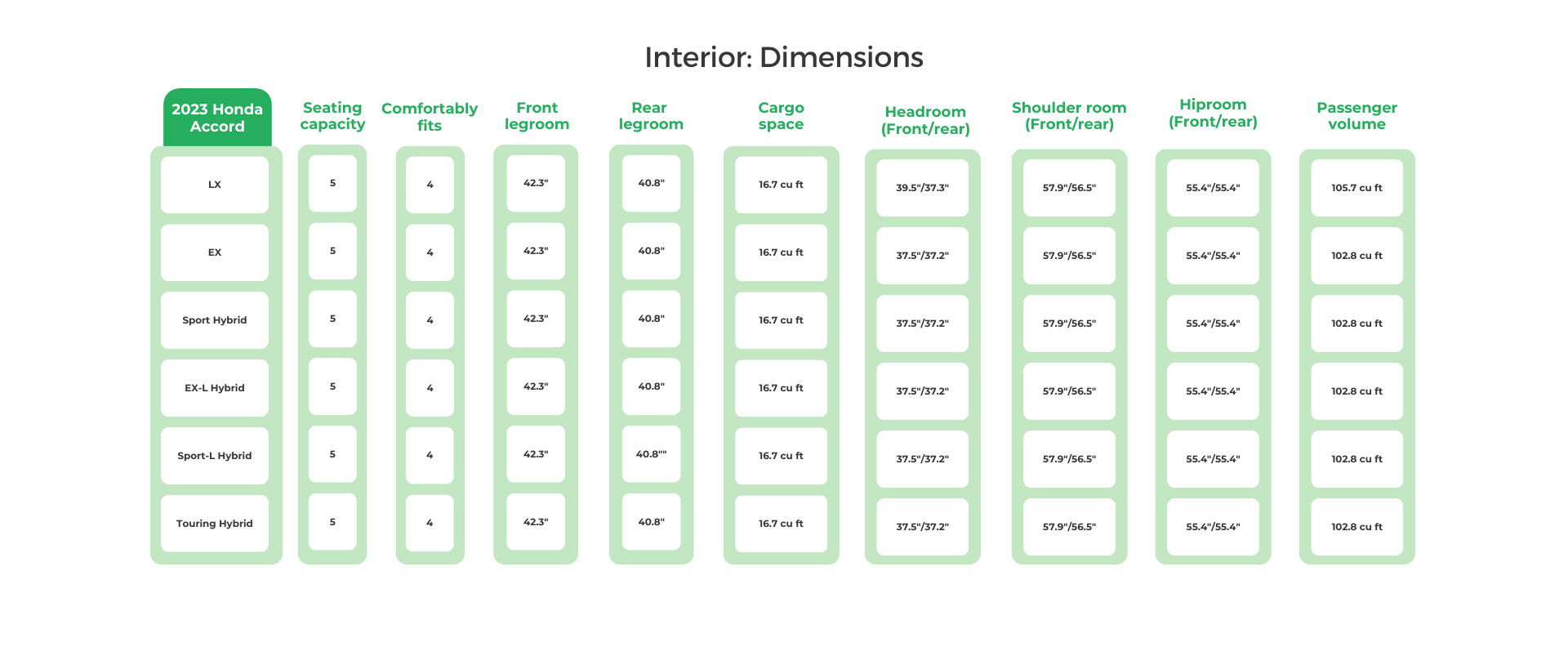
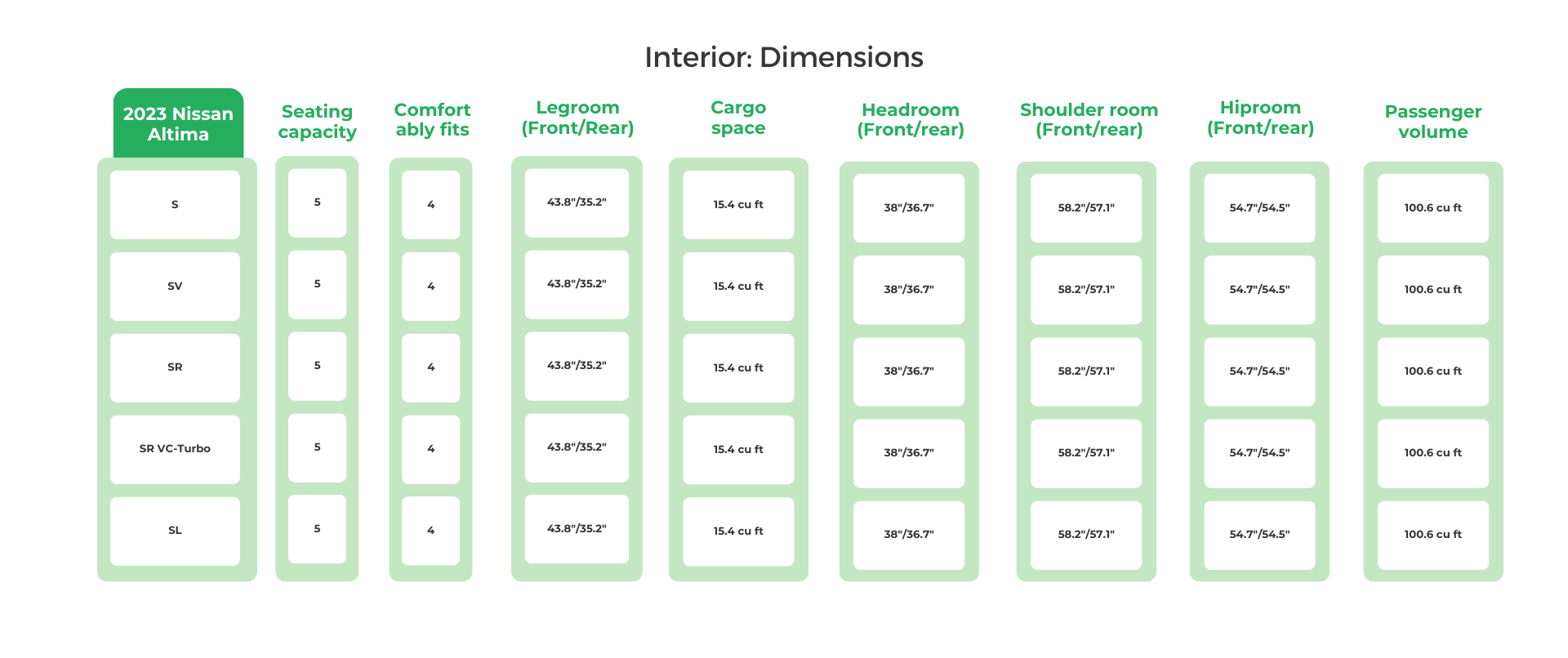
Exterior:
Quick Take: Both of these cars offer some style, but nothing crazy. However, only the Altima can still be had with steelies and hubcaps.
Exterior Features:
Nissan likes to show off its 2023 Altima in SR-VC Turbo spec because it looks dope with those exclusive 19” rims. But be aware that entry-level S models sport dowdy plastic hub caps over 16” steel wheels. These are a whole lot cheaper to replace but don’t do the Atima any favors in the looks department.
The 2023 Accord also offers up to size 19 wheels, along with 17” and 18” in the same various shades of silver and black, but it’s an all-alloy affair at Honda.
As for paint finishes, these two cars offer comparable hues in the white, black, silver, red, and blue end of the rainbow. You’ll need to step down to a Nissan Sentra or Honda Civic for wilder options.
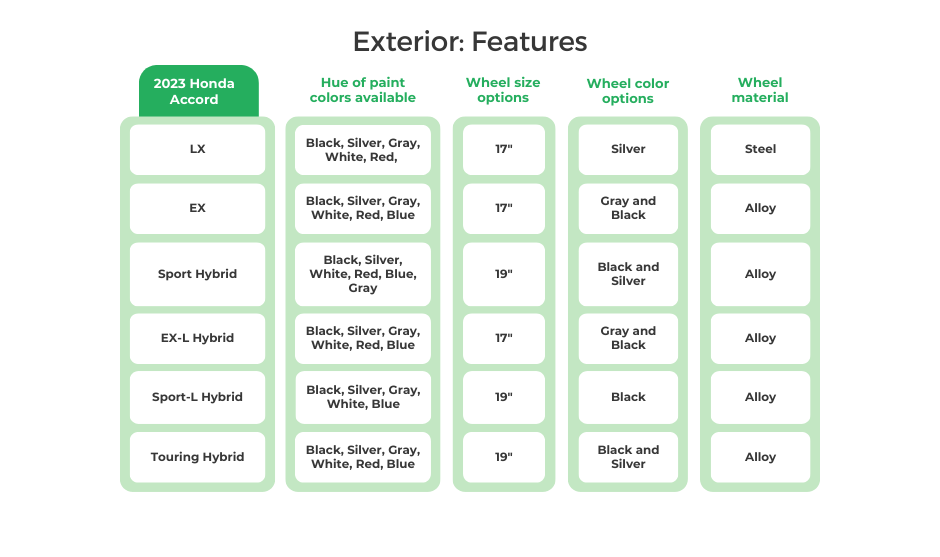
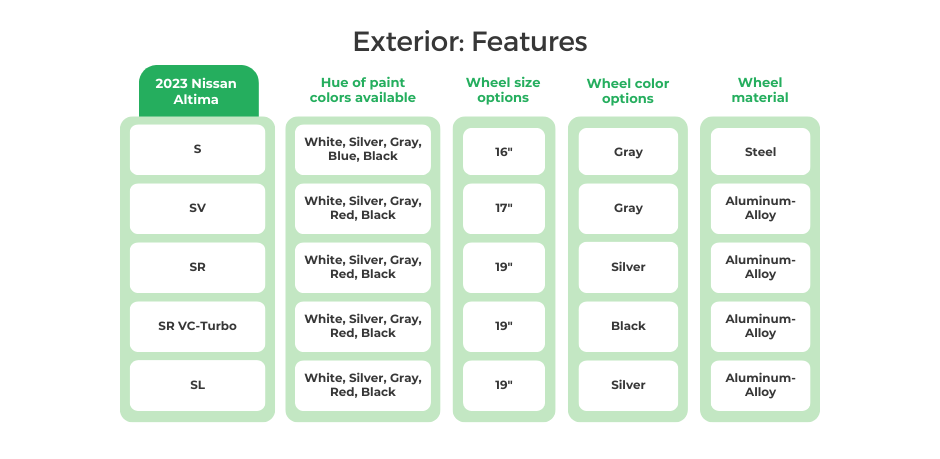
Exterior Dimensions:
As with the inside, the 2023 Honda Accord is slightly bigger outside than the 2023 Nissan Altima with about 3 inches of additional length. But the width, height, wheelbase, and ground clearance dimensions are within a half-inch of each other.
The curb weight figures vary slightly more, but only when you start comparing a hybrid Accord as the battery pack and electric motor are relatively heavy. Of course, as we’ve already seen, these models are the fuel efficiency rock stars even with a couple hundred extra pounds on their frames.
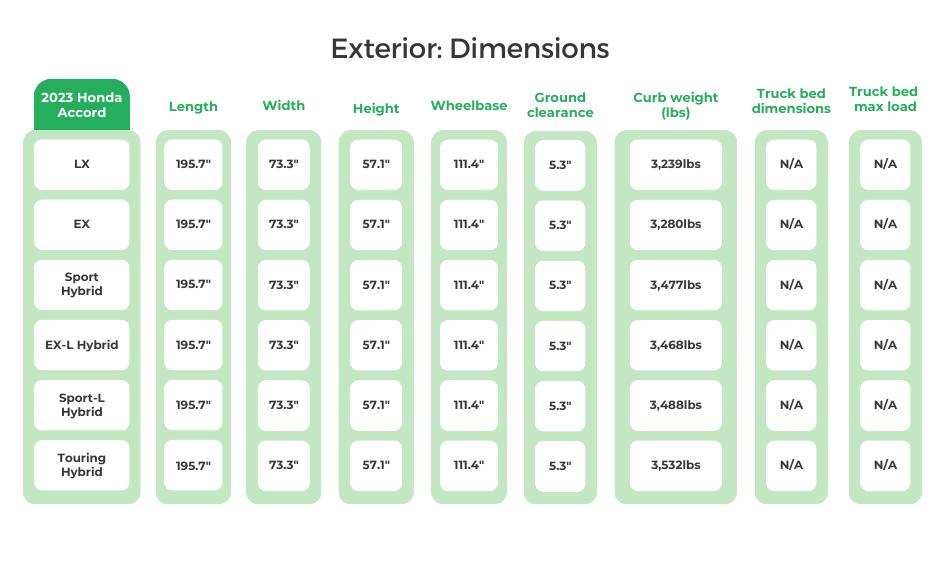
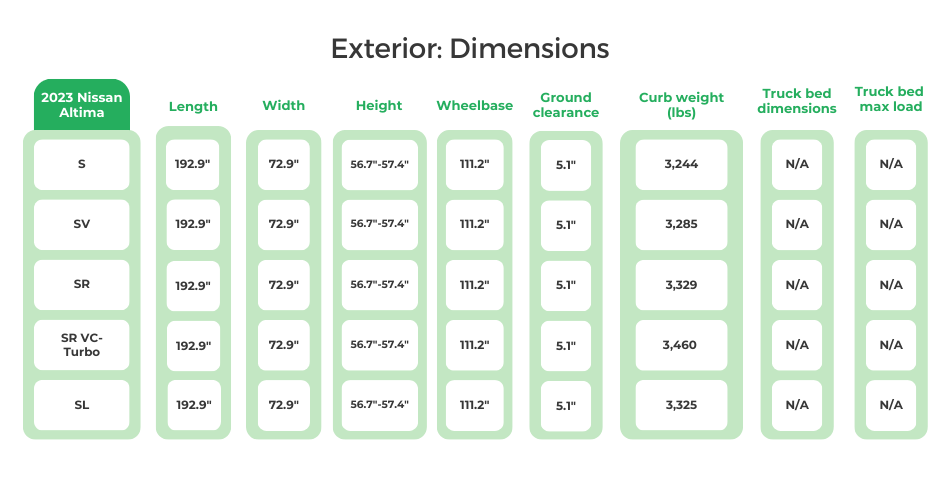
Warranty:
Quick Take: Basic, powertrain, and roadside assistance coverage is identical here, but only the Accord comes with complimentary maintenance.
Typical mainstream vehicle warranty coverage applies to the 2023 Altima and Accord. That means a 3-year/36,000-mile basic warranty and roadside assistance term and a 5-year/60,000-mile powertrain warranty.
But, Honda also includes 2 years of complimentary maintenance, which Nissan does not offer at all.
Currently, only the 2023 Accord has an outstanding recall from the NHTSA. It’s related to a loss of drive power and has impacted just 19 vehicles.
| 2023 Honda Accord Factory Warranty Coverage: | 2023 Nissan Altima Factory Warranty Coverage: |
|
| Basic warranty: | 36 months/36,000 miles | 36 months/36,000 miles |
| Powertrain warranty: | 60 months/60,000 miles | 60 months/60,000 miles |
| Corrosion perforation warranty: | 60 months/unlimited miles | 60 months/unlimited miles |
| Air conditioning warranty: | 24 months/24,000 miles (A/C refrigerant) | 12 months/unlimited miles |
| Battery warranty: | 36 months/36,000 miles | 24 months |
| Emissions warranty: | Federal: 36 months/36,000 miles California: 36 months/50,000 miles | Federal: 36 month/36,000 miles (defect), 24 months/24,000 miles (performance)California: 36 months/50,000 miles (defect), 36 months/50,000 miles (performance) |
| Roadside assistance coverage: | 36 months/36,000 miles | 36 months/36,000 miles |
| Total unique recalls: | 1 | 0 |
Methodology
- Compare two vehicles, the Honda Accord and the Nissan Altima, and provide a comprehensive analysis.
- Gather relevant information and data on both vehicles from reliable sources, such as manufacturer specifications, expert reviews, customer feedback, industry reports, and data sources like manufacturer websites, FIXD App, Kelley Blue Book, FuelEconomy.gov, and NHTSA.
- Collect data on various aspects, including performance, safety features, fuel efficiency, maintenance costs, reliability, owner satisfaction, and market value.
- Identify the key criteria that will be used to evaluate and compare the two vehicles.
- Ensure the criteria cover both objective factors (such as performance metrics, safety ratings, and fuel efficiency) and subjective factors (such as owner satisfaction, comfort, and features).
- Assess the performance of both vehicles based on factors such as acceleration, handling, braking, and overall driving experience.
- Compare engine options, horsepower, torque, transmission options, and any unique performance features.
- Examine the safety features and ratings of both vehicles.
- Evaluate crash test ratings, advanced driver assistance systems (ADAS), active and passive safety features, and any notable recalls or known issues related to safety.
- Consider both NHTSA safety ratings and IIHS awards for a comprehensive safety assessment.
- Analyze the fuel economy of both vehicles based on EPA mileage estimates.
- Compare their MPG ratings, average full-tank range, and any significant differences in fuel efficiency.
- Compare the features and technologies offered by both vehicles.
- Highlight any notable differences in terms of infotainment systems, connectivity options, driver assistance features, interior quality, and available upgrades.
- Summarize the findings of the comparison, highlighting the positives and negatives of each vehicle.
- Provide a fair and balanced recommendation based on the comparison, considering factors such as budget, personal preferences, specific needs of the buyer, and the comprehensive analysis conducted.
Sources:
- Fuel Economy: Mileage-per-gallon estimates according to the EPA MPG on Fueleconomy.gov.
- Annual Maintenance/Repairs: Upkeep expenses as published by Edmunds.com.
- Safety Ratings: Crash test data collected and reported by NHTSA. We average all ratings for each year to come up with a simplified, average safety score. This makes it easier to look at on a graph. We also collected IIHS Awards for this article.
- Vehicle Features: Most or all information gathered on vehicle features were from the manufacturer websites, in this case, NissanUSA.com and Automobiles.Honda.com

Niel Stender grew up doing replacement work on his old Cherokee and sweet Mitsubishi Starion, which led to a degree in mechanical engineering and a job at Ford as a vehicle dynamics engineer. His writing infuses that automotive background with sales and marketing experience. Writing about cars for close to a decade now, he enjoys digging into some of the more technical mechanical systems under the hood and throughout a vehicle.

